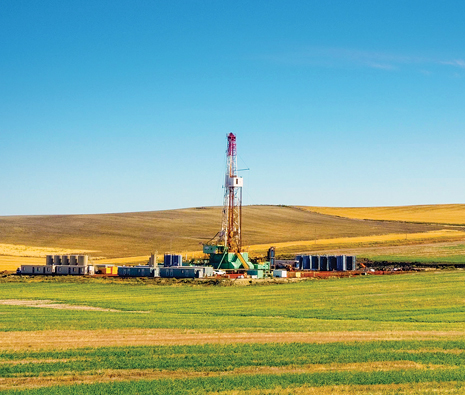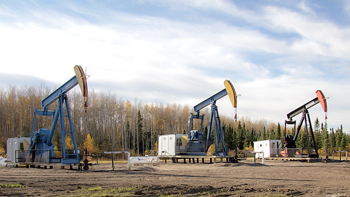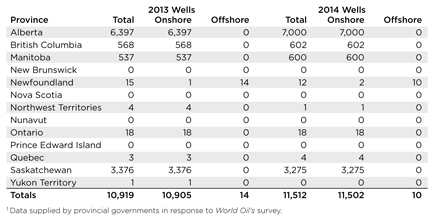 |
| Drilling activity remains strong in North Dakota, where exploitation of the Bakken shale has resulted in statewide production exceeding 1.0 MMbopd for the first time, ever (photo courtesy of Hess Corp.). |
|
After a bit of a lull in first-quarter 2014, U.S. drilling has resumed steady growth over the last four months. Onshore the Lower 48 states, oil-directed activity is king, particularly in the larger shales, as operators strive to benefit from high liquids prices. Offshore, the rig count is up 8%, as activity centers on deepwater mega-projects for oil development.
The factors affecting U.S. drilling are certainly a mixed bag. On the one hand, producers are exploiting incredibly productive shale resources, taking advantage of higher-than-expected oil prices, and benefiting from drilling efficiency gains. They are also looking to shed themselves of surplus gas supplies, once LNG exports begin. On the other hand, producers must deal with regulators in Washington, who continue to devise a host of punitive environmental and land use rules. They are also hamstrung by the White House’s refusal to approve construction of the Keystone XL Pipeline, and must deal with a growing anti-fracing movement within a certain segment of the U.S population.
Nevertheless, the upstream industry is acquitting itself well—boosting drilling, increasing reserves and growing U.S. production. Remarkably, U.S. oil production is running at least 15% higher than at the same time last year, exceeding 8.1 MMbpd.
For the remainder of 2014, World Oil’s forecast (Table 1) includes these highlights:
- U.S. drilling will rise 9.9%, from 22,974 wells in first-half 2014 to 25,256 in the second half
- On a year-to-year basis, U.S. drilling will increase 3.9% to 48,230 wells in 2014, from 46,405 wells in 2013; this compares to our original 2014 forecast of 45,834 wells
- The amount of U.S. footage drilled will increase 9.8%, to 208.8 MMft of hole in second-half 2014, from 190.3 MMft in the first half. Furthermore, year-on-year footage drilled will gain 6.5%, to a near-record 399.1 MMft.
- Given recent gains and a general trend upward, it is conceivable that the U.S. rig count will hit the 2,000 mark before the end of the year and remain at that level for several weeks
- Continued use of pad drilling and further efficiency gains are resulting in a “factory”-type process, whereby E&P companies are becoming immune to flat commodity prices.
| Table 1. Mid-year revision, 2014 U.S. drilling forecast. |
|

|
World Oil’s own proprietary surveys of major drillers, and small- and medium-sized independents, support these findings. Among 14 major drillers (Table 2), activity will increase 23.7% from first-half 2014 to the second half. These operators will also devote 74.9% of their drilling to oil projects during the full year. Among the smaller 75 independents, they plan 1,508 wells, of which 56.7% will be drilled in the second half. Within that total, 1,308 wells, or 86.7%, will be oil-directed. In all, World Oil’s two survey groups, combined, represent 9,300 wells, or just short of 20% of all U.S. drilling.
| Table 2. Drillng plans for 14 major U.S. drillers1 |
|

|
U.S. prices. As this year began, there were concerns and some expectations of a soft U.S. oil market. Some analysts predicted that oil prices would only average, at best, in the low $90s for the year. This has proven not to be true. Indeed, prices have shown remarkable resilience, buoyed in part by violence in the Middle East and Ukraine, and worries about security of supplies in some parts of the world. If it were not for the gains in U.S. oil output, which have added significant amounts of crude to the world market, prices might be averaging at least $10/bbl above this summer’s low $100s/bbl.
Meanwhile, natural gas prices at the Henry Hub averaged $4.59/Mcf in early June. However, they have taken a dive since then, falling to just below $3.90/Mcf at the end of July before leveling out. According to the U.S. Energy Information Administration (EIA), as of midway through the summer storage injection season, working natural gas in storage is on pace for a record overall build. EIA projects a record build of close to 2.6 Tcf, from the beginning of April through the end of October, which would put inventories at 3.431 Tcf.
Following a colder-than-normal winter, storage inventories at the end of the heating season were only 857 Bcf, the lowest level since 2003, said EIA. While the refill season began slowly in April, injections ramped up quickly in May and have substantially exceeded five-year average levels since then. Strong domestic production and moderate demand for gas to generate electricity, due to a relatively cool summer, have led to this year’s strong injections. Natural gas marketed production continues to set records, as new wells come online in the Marcellus and Eagle Ford shales. EIA expects production growth to continue, and the strength of supply is reflected in lower gas prices.
U.S. rig count. As of Aug. 1, the Baker Hughes U.S. rotary rig count was 1,889, up 107 units, or 6%, from the 1,782 figure of the same week in 2013. For the first seven months of 2014, the U.S. rig count averaged 1,825.9, up 3.7% from the 1,761.1-unit level of the same period in 2013. Most of the growth came onshore, where the average was 1,770.0, compared to 1,708.2 a year earlier. The nearly-62-unit increase onshore can be traced mostly to growth in three states—Texas (up 38 rigs), Oklahoma (up nine rigs) and Wyoming (up five rigs). Given operators’ plans, nationwide, for the remainder of 2014, we expect to see further growth in the U.S. rig count. It is not unreasonable to think that it may hit 2,000 units before the end of the year, and it could stay there for multiple weeks.
A year ago, the oil-gas split in the Baker Hughes U.S. rig count sat at 78% oil, 22% gas. Since then, the split has widened further and now stands at 83% oil, 17% gas.
State-by-state highlights. All the trends that were in place a year ago have continued—oil is the overwhelming target for producers, while a small amount of gas drilling continues, primarily to hold leases or maintain production. Liquids-rich shales are the formations of choice, which is driving further growth in horizontal drilling. In a few key states, shale activity accounts for an overwhelming proportion of all drilling, as horizontal sections continue to lengthen, and the number of frac stages increases.
In Texas, the primary drivers of activity remain the Eagle Ford shale of South Texas and the Permian basin of West Texas. Drilling and development in the Eagle Ford (Railroad Districts 1, 2 and 3) is running at capacity, hence the combined number of wells forecast to be drilled in the two primary districts—1 and 2—will be level with last year at 4,454.
In the Permian basin (Districts 8, 8A and 7C), oil-directed drilling constitutes about 98% of all activity. In our own proprietary survey of operators, a cross-sectional group of five major drillers in District 8, along with another five smaller independents, will drill 1,068 wells this year, of which 1,039, or 97%, are oil-directed. This group also will increase activity 5% in second-half 2014. Overall, we expect drilling to gain 5.9% in District 8, 22.6% in District 7C (our sample group up 23.5%) and 6.2% in District 8A. The proportion of horizontal drilling continues to increase, as does total footage per well.
On the flip side of the oil-driven prosperity, activity is still struggling in gas-prone districts. In Districts 4 (deep South Texas, along the Gulf Coast), 5 (Barnett shale, East Texas) and 6 (East Texas), combined, second-half drilling will be up a meager 3.7%, at 730 wells. For the year, these districts will still be down 3%, at 1,438 wells.
To the north, in Oklahoma, activity is strong and continues to grow, due almost exclusively to oil-directed efforts. A combination of conventional and tight oil work is responsible for pushing the oil share of drilling to 85%. The rig count has grown over the last 12 months from 183 to 192. Overall, we see the state’s activity growing a further 11.3% during second-half 2014, and totaling 3,457 wells for the year, up 7.5% from the 2013 figure.
In Louisiana, according to the Department of Natural Resources’ Office of Conservation, oil activity remains steady in the northern half of the state, while gas-directed drilling shrinks further. Hence, while second-half drilling will be up slightly in northern Louisiana, the yearly total will be down 8%, at 797 wells. In the southern half, the skew toward oil has widened from 80% to 85%. Footage per well is also rising. We expect drilling in South Louisiana to rise 17% in second-half 2014 and be up 9.6% for
the year.
As the industry builds further infrastructure in North Dakota, operators are able to increase activity further. Accordingly, drilling, led by the prodigious Bakken shale oil play, will gain 10.5% during second-half 2014. For the year, North Dakota will drill 2,379 wells, up 9.4% from 2013’s level. After a lull in early 2014, the state’s oil production growth resumed, and, at mid-year, finally surpassed 1.0 MMbpd, with further growth expected. The state’s leading operator is Continental Resources, with another major player being Hess Corp.
In the Northeast, Pennsylvania is experiencing strong activity, as operators exploit the wet gas and liquids windows of the Marcellus shale. There is an accelerating trend, so that second-half drilling is predicted to be 21.2% higher than in the first half. For the year, Pennsylvania will tally 2,276 wells, up 1.4% from the 2013 figure. To the west, in Ohio, exploitation of the oil-prone Utica shale has hit its stride, as has conventional oil activity. Drilling will be up 22.2% in the second half, and will gain an equal amount for the year at 851 wells, compared to 2013’s level. The Marcellus, is also treating West Virginia kindly, as liquids-directed activity continues to grow. Drilling will be up 22.1% in the second half, while the annual total will be up 6.5%, at 602.
In the Rockies, there will be strong second-half drilling gains in Colorado (+11.3%), New Mexico (+24.4%) and Utah (+38.4). For the year, Colorado will be up 3.2%, and New Mexico will rise 14.1%, while Utah will be level with last year. Colorado continues to benefit from high work levels in the DJ basin of the Nirobrara shale, along with the Piceance basin. While oil-directed drilling has been carrying New Mexico in the southeastern part of the state, there is also an uptick in oil activity in the northwestern portion, as well. Two major players in Utah are Newfield Exploration and LINN Energy, and 100% of their efforts are oil-directed.
California’s E&P activity remains almost entirely oil-directed. In fact, World Oil’s survey group, which accounts for two-thirds of all wells in the state, will devote 92% of its efforts toward oil development. Leading operators include Occidental, Aera Energy, Chevron and LINN Energy (the latter assuming prominence after acquiring Berry Petroleum). For the second half, producers will increase California onshore drilling 7.9%. On an annual basis, the state’s drilling will total 3,266 wells, up 4.0% from the 2013 tally.
Up in Alaska, activity in the Arctic offshore remains idle, as Shell has opted to forego any work for a second consecutive year, leading other operators to postpone activity. Across the rest of the state, steps taken by officials to ease the tax and regulatory burden have paid dividends. Activity is up in traditional areas, as evidenced by moderately increased rig counts. Drilling will be split almost evenly between the two halves of the year, with the 2014 total forecast to be 153, up 5.5%.
About these statistics. World Oil’s U.S. tables are produced with the aid of data from a variety of sources, including API, the Texas Railroad Commission, other state and federal regulatory agencies, and a variety of operators. We thank all contributors for their time and effort in providing data and analysis.
CANADA
 |
| Fig. 1. Following the trend in the U.S., pad drilling is being utilized more frequently in Western Canada, as reflected by this cluster of pumpjacks (photo courtesy of ARC Resources Ltd.). |
|
Given consistently strong oil prices, and recovering natural gas prices in North America, the outlook is as good as it has been in many years for the Canadian industry. But political forces continue to destabilize markets across the continent, with pipeline issues festering in Canada and the U.S., and fear-mongering about oil sands development rampant among anti-industry activists.
Overall, drilling activity is up, and producers are showing improved financials (thanks largely to a weaker Canadian dollar). They have overcome the lack of pipeline capacity growth with an enormous shift to oil shipments by rail.
M&A activity. Testament to the upturn seen by the Canadian oil patch this year is C$16 billion in mergers and acquisitions through the first half of 2014, dwarfing the $4.3 billion in deals through first-half 2013. Increased oil and gas prices, and the lower Canadian dollar, are big reasons for the enhanced M&A activity. The improved financials have increased cash flow, access to capital, and better financing opportunities. Leading the way this year was Canadian Natural Resources Limited’s C$3.1 billion, February acquisition of Devon Energy Corp.’s conventional Canadian energy business, which is 73% natural gas-weighted.
In late June, EnCana sold its Bighorn assets to Jupiter Resources Inc. for C$1.8 billion. These assets consist of 360,000 acres in west-central Alberta, representing reserves of 1.1 Tcf of gas and liquids-equivalent, of which 75% are gas.
In March, Whitecap Resources Inc. acquired assets in Alberta and British Columbia (B.C.) from Imperial Oil Ltd. for C$855 million. The assets, with a 50/50 oil/gas split, produce approximately 15,000 boed. Meanwhile, in late June, Montreal-based SNC-Lavalin Group Inc. acquired Kentz Corporation Limited, a London, UK-based engineering firm, in an all-cash deal worth C$2.1 billion.
In addition, Talisman is said to be considering disposal of some, or possibly all, of its Asian portfolio, valued at about C$4 billion. EnCana is rumored to be considering the sale of its Deep Panuke gas project offshore Nova Scotia, valued as high as $2 billion.
Reserve additions. Canadian producers also put up some positive reserve addition numbers in 2013, for both oil and gas. According to Daily Oil Bulletin records, total proved oil and liquids reserves rose to 29.5 Bbbl last year, a 10% increase over 26.74 Bbbl in 2012. Almost 84% of the booked reserves were associated with Alberta oil sands. On the gas side, proved reserves rose to 36.9 Tcf, up nearly 2% from 36.3 Tcf in 2012. The increase on the gas side is predominantly due to bookings from liquids-rich gas plays.
The increase in oil sands reserves did not come without cost, however. A recent report issued by the Canadian Energy Research Institute (CERI) shows that the cost of mining and upgrading projects rose 5.9%, Steam Assisted Gravity Drainage (SAGD) projects increased 4.4%, and stand-alone mine costs were up 1.6%. CERI also forecasts that natural gas usage by oil sands projects will increase as much as three-fold by 2048.
Land sales. A key indicator of future activity in Western Canada is land sales activity. Leases and licenses acquired in these sales form the basis for future drilling plans. Optimism about future activity may be tempered by the news that revenue from land sales has decreased compared to first-half 2013.
Through six months, land sales brought in C$431.85 million, down 24% from the $569.35 million garnered at the half-way point last year. The six-month record was set in 2006, when governments took in $2.7 billion.
Despite the year-over-year decrease, Alberta once again led the way, taking in 54% of the total at $231.55 million. That was 44% lower than last year, when Alberta took in $411.48 million.
B.C. also showed a big decrease through six months, with land sale revenues decreasing 29%, to $89.87 million, compared to $127.45 million in 2013. Both totals are dwarfed by the $609 million that B.C. collected in 2010. Bucking the downward trend was Saskatchewan, which saw its revenue increase substantially to $109.59 million, up 274% from $29.26 million during first-half 2013.
Drilling/production. Drilling numbers were up slightly during first-half 2014, when 4,886 wells were drilled, up marginally over last year’s 4,815. Among the wells drilled this year, 65% targeted oil, and 84% were for development.
But, based on a stronger-than-expected second quarter, both of Canada’s industry associations have increased their 2014 forecasts. In June, the Canadian Association of Oilwell Drilling Contractors revised its 2014 Western Canadian forecast upward to 11,494 wells drilled, a 6% increase over 2013 drilling. In July, the Petroleum Services Association of Canada also revised its Western Canadian forecast upward for a second time this year, predicting there will be 11,460 wells drilled during 2014.
Nationally, including offshore Eastern Canada, the Canadian Association of Petroleum Producers (CAPP) says that 10,878 wells were drilled last year, and predicts an 8.7% jump in 2014 to 11,825 wells. CAPP says that offshore activity will rise 47%, from 17 wells in 2013 to 25 this year. Shadowing CAPP fairly closely, the National Energy Board (NEB) says that 10,853 wells were drilled in Canada last year, and predicts a 6.0% rise to 11,494 this year. Curiously, NEB is calling for a reduction in offshore wells from 13 to 8.
Every six months, World Oil consults with provincial governments across Canada. Some of the data derived is shown in Table 3. When added together, the individual provinces parallel the CAPP and NEB numbers very closely. They show 10,919 wells last year, with a 5.4% rise to 11,512 expected in 2014.
| Table 3. Canadian drilling, by province, 2014 vs. 20131 |
|

|
Meanwhile, World Oil’s survey of a cross-section of Canadian operators is also bullish on the second half, showing that drilling will increase about 20% over first-half totals. Representing 21% of all Canadian drilling, based on CAPP’s forecast for 2014, the survey group drilled 1,114 wells in the first half and will boost that effort 20% during the second half. In this group, 73% of wells were targeting oil in the first half, and that figure will rise slightly to 74% in the second half. An overwhelming 95% of wells were for development in the first half, and that same figure applies to second-half drilling.
As regards production, CAPP says that total Canadian oil output averaged 3.344 MMbpd last year, and that figure continues to grow. This total includes 1.381 MMbpd of conventional crude, 22,392 bpd of condensate and 1.941 MMbpd of oil sands production. Actively producing oil wells totaled 71,601, of which 6% were flowing naturally. Output of natural gas averaged 14.015 Bcfd, and actively producing gas wells totaled 145,099.
Oil transportation. There have been some encouraging signs on both sides of the border regarding pipelines, but skepticism abounds that neither the proposed TransCanada Pipelines Keystone XL project, nor Enbridge’s Northern Gateway pipeline, will be in service any time soon, if ever. Oil sands producers cast a wary eye to both; hopeful, but not counting on either. In response, Enbridge is reviewing the feasibility of building a 140,000-bpd rail facility in Illinois, to alleviate pressure in shipping Canadian oil to U.S, markets.
As the Keystone soap opera drags on in the U.S., the C$5.5-billion Northern Gateway proposal got a significant boost in June, securing approval from Canada’s National Energy Board (NEB), with 209 conditions attached. Enbridge will take the next year or more to assess the conditions and make a decision on whether to proceed. Despite NEB’s approval, extensive opposition remains in B.C. The project would transport oil sands crude from Alberta to the B.C. coast, for shipment to Asian markets. Imported diluent would also be shipped back to Alberta. Opponents have cited concerns with both the pipeline and increased oil tanker traffic it would generate on the West Coast. This is despite continued opposition from B.C.’s provincial government, even though its approval is not required.
Oil sands impacts. Meanwhile, efforts to reduce greenhouse gases (GHG) across North America have re-emerged as an issue that may impact Alberta’s oil sands. Companies fret that following the release of the U.S. Environmental Protection Agency’s Clean Power Plan, which requires a 30% reduction in carbon emissions from U.S. power plants by 2030, Barack Obama may be unfettered in pursuing a more aggressive stance toward Canada’s oil sands and their GHG emissions. By extension, that could be further bad news for the Keystone XL project.
The tired GHG argument against oil sands development has been refuted by numerous studies, most of which have shown that oilsands development results in minimally higher GHG emissions than conventional oil development. Most recently, IHS CERA released a report that found almost half of the crude utilized in the U.S. has a GHG intensity range similar to the oil sands.
Traditional lands questions. Further concern has arisen about the implications of a ruling from the Canadian Supreme Court on June 26, 2014—Tsilhqot’in Nation v. British Columbia—in which the court determined that the Tsilhqot’in Nation had proved aboriginal title to almost 2,000 km2, considered by the Tsilhqot’in to be traditional lands. The case arose after the B.C. government had granted logging rights on these lands in 1983.
The implications of the case on oil and gas development across Canada are unknown. Yet, speculation is rampant that other First Nations across the country will make similar applications to claim aboriginal title on traditional lands impacted by other development, for which provincial governments have granted permits or licenses.
MEXICO
From an operational and financial standpoint, Mexico is in a delicate transition. Two key financial items have the ability to strengthen exploration in the nation.
The first factor is the upgrading of Pemex’s credit rating—to A3—by Moody’s Investor Services. The upgrade results from improved prospects afforded by the changes proposed by Mexico’s Energy Reform Law and its associated legislation. Key changes include alterations to Pemex’s corporate structure, and the opportunities that the company has to engage in JVs.
The second factor is Pemex’s recent sale of 104 million shares of Repsol stock, which is 7.86% of its capital and valued at $2.95 billion. These resources will be available for exploratory projects, such as the Chuc exploratory well in 2014, as well as financing 55% of the projected capital investment in the Cantarell (Fig. 2) and Ku-Maloob-Zap field complexes, or provide resources for the Tsimin-Xux facilities. All of these are strategic investment projects that are very important to Pemex, for which, the company will finance $27.7 billion in capital investment for this year. That figure is 6.5% higher than the investment level during 2013. About 85% of the budget is earmarked for E&P.
 |
| Fig. 2. The sale of Repsol stock valued at $2.95 billion will allow Pemex to invest money in capital projects, such as work at Cantarell and Ku-Maloob-Zap fields, that would otherwise be reduced or not occur at all. |
|
However, it is also important to note that the aforementioned energy reforms will allow Pemex to set up subsidiaries for specific activities, such as E&P, which, in the latest version of the legislation, will be an activity conducted by subsidiaries. In fact, Article 59 states that “Pemex will operate through subsidiaries’ productive enterprises for the exploration and extraction of hydrocarbons,” through contracts granted by the government, as well as being able to create private JVs.
Lourdes Melgar, undersecretary for oil and gas in the Secretariat of Hydrocarbons, has said that Pemex will probably keep the exploration projects in the southeastern part of the country (offshore Tabasco and Campeche), where it has the most experience, for itself. These proven reserves are estimated at around 14 Bbbl of oil, which would place Pemex among the world’s five largest oil companies, due to the value of its reserves.
All measures to consolidate the exploration sector will be implemented from now, based on the hydrocarbon policy set out in “Round Zero.” The goals of this document are to create a balance between the resources that Pemex manages, and those that the state administers and will give out in later rounds. While simultaneously endowing the necessary resources to ensure Pemex’s production levels, it multiplies investment in exploration and extraction of oil and gas in the country, through bidding rounds in which participants from both the wider industry and Pemex may compete. Taking this into account, in the area of exploration, Pemex requested the prospective resources detailed in Table 4.
| Table 4. Under the reform package, Pemex has requested prospective resources equaling 34.5 Bbbl (table courtesy of Pemex). |
|

|
Thus, Pemex will have resources equivalent to 31% of accumulated production, with the goal of maintaining operations at the present level of output until 2050. This frees 407,000 km2, as of 2015—which were previously assigned to Pemex—for the Mexican state to conduct 10 auctions (rounds) of 20,000 km2, each.
It is hoped that these new actions and operational tools will help to change the results seen in the latest Pemex report on Mexican oil production, which dropped 1.08% during first-quarter 2014, compared to the same time last year. New statistical analysis, conducted by Pemex, shows that the drilling of exploration wells has decreased significantly in the last few years. Pemex only drilled six exploratory wells—and 129 development wells—in the first three months of 2014.
According to data for the first quarter of this year, crude oil exports fell 1.1%, compared with the same period in 2013, from 1.204 MMbpd to 1.191 MMbpd, shipped abroad to three main destinations: the U.S., Spain and India. 
|










